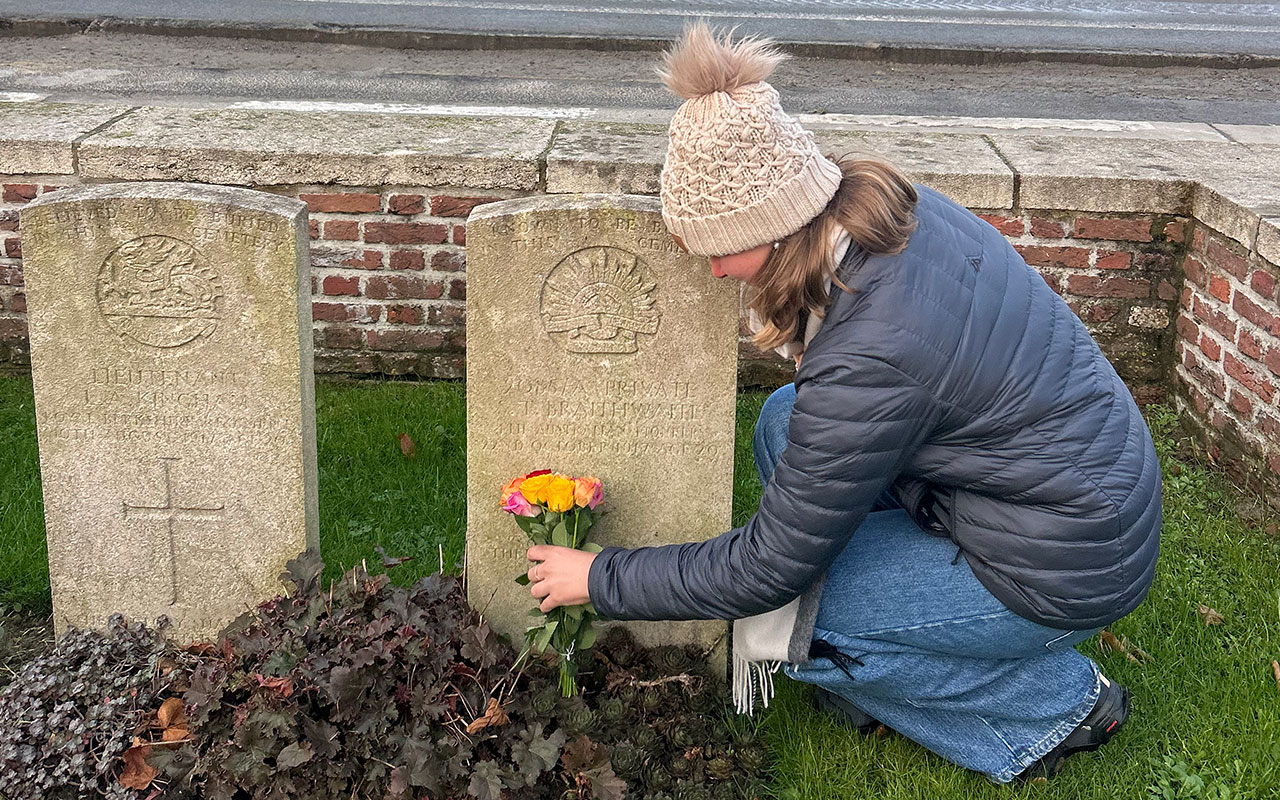
Remembering the ANZACs: A personal journey through history.
April 28, 2025
by Ashley Whitehead, Year 11
Cathedral School Year 11 student, Ashley Whitehead, shared a moving and deeply personal reflection at our ANZAC Day Service, 2025. Ashley, who has been boarding with us since 2021 from her family’s cattle station in western Queensland, recently travelled through Europe as part of the Cathedral School’s Europe Tour.
Inspired by her family’s military history, Ashley took the opportunity to trace the footsteps of her great-grandfather and his brother, both ANZAC soldiers who fought on the Western Front during World War I. Her speech recounts not only their extraordinary stories of courage and survival but also her emotional experience visiting the very battlefields and cemeteries where her ancestors once stood.
Please take a moment to watch Ashley’s heartfelt speech below, as she honours the legacy of all those who served.
Transcript:
‘Good morning everyone. My name is Ashley Whitehead, and I am sure to some I am a familiar face here at Cathedral. Coming from a remote cattle station in western Queensland, I have been boarding here since 2021, and am currently battling through grade 11.
At the end of 2023 as Term 4 came to a finish, I was doing my daily scroll through eCat newsfeed and noticed something that was definitely different to the usual room changes, and JR’s interschool sport posts. In bold letters, it read “Cathedral Europe Tour, 2024”. With the prospect of travelling through the Netherlands, Belgium and France, I got on the phone instantly to Mum and Dad and explained to them how I would surrender to child labour if they let me go. Lucky enough for me this begging was successful, but only under one condition. I was told that it would be a waste of my trip if I didn’t learn about my family history, and my close connections to a few courageous men who fought on these foreign lands in World War I.
After I began to research, I quickly discovered relations on my mother’s side of the family, whom of which were a part of the heroic ANZAC troops at Gallipoli and the Western Front in World War I. My great-grandmother had three brothers who were diggers, with one paying the ultimate price at Gallipoli and the other 2 getting wounded on the Western Front. However, I took a lot of interest in my great-grandfather, Septimus Braithwaite and his younger brother Sydney Braithwaite, who spent their time serving Australia, battling predominately on the western front. Their involvement in the war stood out greatly to me, as I would be touring the exact same battlefields they fought on approximately 109 years beforehand.
Septimus, only 20 years young, enlisted for the Australian army corps in Cloncurry, when he was working as a station hand on a nearby cattle property. Unknowingly entering a slither of hell, he travelled to a war-ridden Europe mid 1916 and entered the firing line soon after. As you can see on the screen, he fought in many battles during his service. He had an amazing stroke of luck, unlike thousands of other ANZACs, and managed to push through the slaughter of war complete. In one case only 7 out of 98 soldiers in his battalion came out of a battle alive, and he was one of them. Without this end result, I would definitely not be here today. It is astonishing that his only memento throughout the war was a German sniper bullet that shot through his backpack and lodged itself into his canvas shaving kit.
Even though he was in a different division to his brother Sidney, they fought alongside one another in a handful of infamous battles. One of which was Polygon Woods located in Flanders field, where Cathedral students were given the opportunity to do a guided tour throughout. We were shown unimaginable photos of the woods at the time of the battle, and saw for ourselves the usual state of it without artillery damage. As I had this direct family connection to Sept and Sydney who were engaged there, I developed a much higher appreciation and respect for all ANZACs. For many soldiers an entire lifetime was wasted by the wrath of war. Living and fighting under such inhumane conditions on the other side of the world showed the courage and bravery ANZACs possessed.
Sydney sadly passed away after being severely gassed at the battle of Passchendaele in late 1917, at the age of 20. He was buried at Birr-Cross Roads cemetery, close to Ypres in Belgium. On our way through the countryside we stopped at this cemetery in our massive school bus, and all of the students made it their task to find his grave. After searching for what seemed like an eternity and not finding anything, Mr Midson sang out and let us all know that he had located it. In fact, it was the first one as you walk through the gate. As I stood in front of his headstone a wave of emotion washed over me, knowing the incredible courage he showed serving as an ANZAC. I couldn’t have been any prouder of the sacrifice he made for his country, family and mates. Out of respect, I recited a poem written by one of my grandfathers brothers, expressing our gratefulness for him and numerous other diggers.
I am sure that many people in this room have connections and stories just like mine to ANZAC’s who honourably served in World War I. After all, even though well over 100 years have passed, all generations since have lived in their essence, and for this we owe them our highest regard. Thank you.’
VIEW NEXT POST






